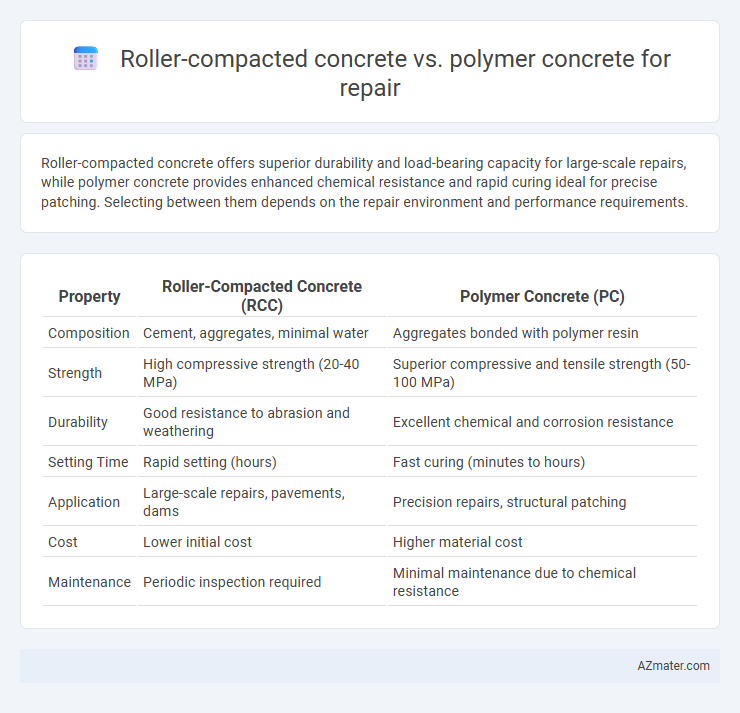Roller-compacted concrete offers superior durability and load-bearing capacity for large-scale repairs, while polymer concrete provides enhanced chemical resistance and rapid curing ideal for precise patching. Selecting between them depends on the repair environment and performance requirements.
Table of Comparison
| Property | Roller-Compacted Concrete (RCC) | Polymer Concrete (PC) |
|---|---|---|
| Composition | Cement, aggregates, minimal water | Aggregates bonded with polymer resin |
| Strength | High compressive strength (20-40 MPa) | Superior compressive and tensile strength (50-100 MPa) |
| Durability | Good resistance to abrasion and weathering | Excellent chemical and corrosion resistance |
| Setting Time | Rapid setting (hours) | Fast curing (minutes to hours) |
| Application | Large-scale repairs, pavements, dams | Precision repairs, structural patching |
| Cost | Lower initial cost | Higher material cost |
| Maintenance | Periodic inspection required | Minimal maintenance due to chemical resistance |
Introduction to Concrete Repair Solutions
Roller-compacted concrete (RCC) offers a durable, cost-effective solution for large-scale infrastructure repairs due to its high compressive strength and rapid placement capabilities. Polymer concrete, enhanced with resins, provides superior chemical resistance, adhesion, and reduced curing times ideal for precise or chemically aggressive environments. Selecting the appropriate concrete repair material depends on project-specific requirements such as load capacity, environmental exposure, and repair speed.
Overview of Roller-Compacted Concrete (RCC)
Roller-compacted concrete (RCC) is a dry mix concrete placed with earth-moving equipment and compacted by rollers, offering high density and strength ideal for heavy-duty repairs like pavement and industrial floors. RCC's low slump consistency allows rapid construction with minimal formwork and reduced curing time compared to conventional concrete. Its cost-effectiveness and durability make RCC a preferred choice for large-scale repair projects requiring robust load-bearing capacity and resistance to abrasion.
Understanding Polymer Concrete
Polymer concrete consists of a composite material where polymer resins replace cement as the binder, providing superior chemical resistance, high tensile strength, and rapid curing times compared to roller-compacted concrete (RCC). Its enhanced adhesion and low permeability make polymer concrete ideal for durable repairs in aggressive environments and infrastructure requiring quick turnaround. Unlike RCC, which relies on cementitious mixtures compacted by rollers for structural mass, polymer concrete excels in precision bonding and abrasion resistance critical for maintenance and restoration tasks.
Material Composition and Properties
Roller-compacted concrete (RCC) consists of a drier mix of cement, aggregates, and water with minimal fines, allowing it to be compacted by rollers for rapid construction and high compressive strength. Polymer concrete incorporates synthetic resins such as epoxy, polyester, or vinyl ester as binders instead of traditional cement, resulting in superior chemical resistance, enhanced adhesion, and exceptional durability in aggressive environments. The lower porosity and faster curing times of polymer concrete make it ideal for precision repairs requiring high tensile strength and chemical stability, whereas RCC is favored for large-scale, cost-effective structural rehabilitation with good load-bearing properties.
Strength and Durability Comparison
Roller-compacted concrete (RCC) offers high compressive strength ranging from 20 to 40 MPa, making it suitable for heavy-duty pavement repairs with excellent durability under repetitive loading and environmental stress. Polymer concrete, reinforced with thermosetting resins, exhibits superior tensile strength and chemical resistance, outperforming RCC in aggressive environments such as wastewater treatment plants or chemical spills. While RCC provides cost-effective, rapid-setting repairs for large areas, polymer concrete ensures long-term structural integrity where enhanced bonding and impermeability are critical.
Installation and Application Methods
Roller-compacted concrete (RCC) is installed using heavy rollers for rapid compaction, making it ideal for large-scale pavement repairs requiring quick curing and high durability. Polymer concrete involves mixing polymer resins with aggregates, applied through pouring or troweling, offering superior chemical resistance and strong adhesion on smaller, precision repair projects. RCC suits infrastructure with heavy traffic loads, while polymer concrete excels in environments exposed to corrosive materials or requiring precise repairs.
Cost Analysis and Lifecycle Value
Roller-compacted concrete (RCC) offers lower initial costs due to its rapid placement and reduced labor requirements compared to polymer concrete, which involves higher material expenses but provides superior chemical resistance and durability. The lifecycle value of polymer concrete often surpasses RCC in aggressive environments, as its enhanced resistance reduces maintenance frequency and extends service life. Cost analysis must consider both upfront expenditures and long-term performance, with polymer concrete delivering better value in applications demanding high durability despite its higher initial investment.
Environmental Impact and Sustainability
Roller-compacted concrete (RCC) features lower cement content and uses local aggregates, resulting in reduced carbon emissions and energy consumption compared to conventional concrete, enhancing its environmental sustainability. Polymer concrete employs synthetic resins like epoxy or polyester, which offer superior chemical resistance and durability but rely on non-renewable petrochemical resources, raising concerns about its ecological footprint. Life-cycle assessments highlight RCC's advantage in reducing greenhouse gas emissions and enabling easier recycling, while polymer concrete's longevity minimizes repair frequency, balancing initial environmental costs with long-term sustainability.
Best Use Cases and Limitations
Roller-compacted concrete (RCC) is ideal for large-scale infrastructure repairs such as highways and dam surfaces due to its high compressive strength and rapid placement capabilities, but it is limited by lower tensile strength and surface finish quality. Polymer concrete excels in repairing structures requiring chemical resistance, bonding to existing concrete, and rapid curing, making it suitable for industrial floors and bridge decks; however, its higher cost and sensitivity to temperature variations can restrict widespread application. Selecting between RCC and polymer concrete depends on project-specific demands like load-bearing capacity, environmental exposure, and curing time constraints.
Final Verdict: Choosing the Right Material for Repair
Roller-compacted concrete (RCC) offers high compressive strength and durability, making it ideal for large-scale infrastructure repairs subjected to heavy loads. Polymer concrete provides superior chemical resistance and rapid curing, suitable for precision repairs in environments exposed to aggressive chemicals or requiring minimal downtime. Selecting the right material depends on the repair context: RCC excels in structural robustness, while polymer concrete delivers targeted performance in specialized conditions.

Infographic: Roller-compacted concrete vs Polymer concrete for Repair
 azmater.com
azmater.com